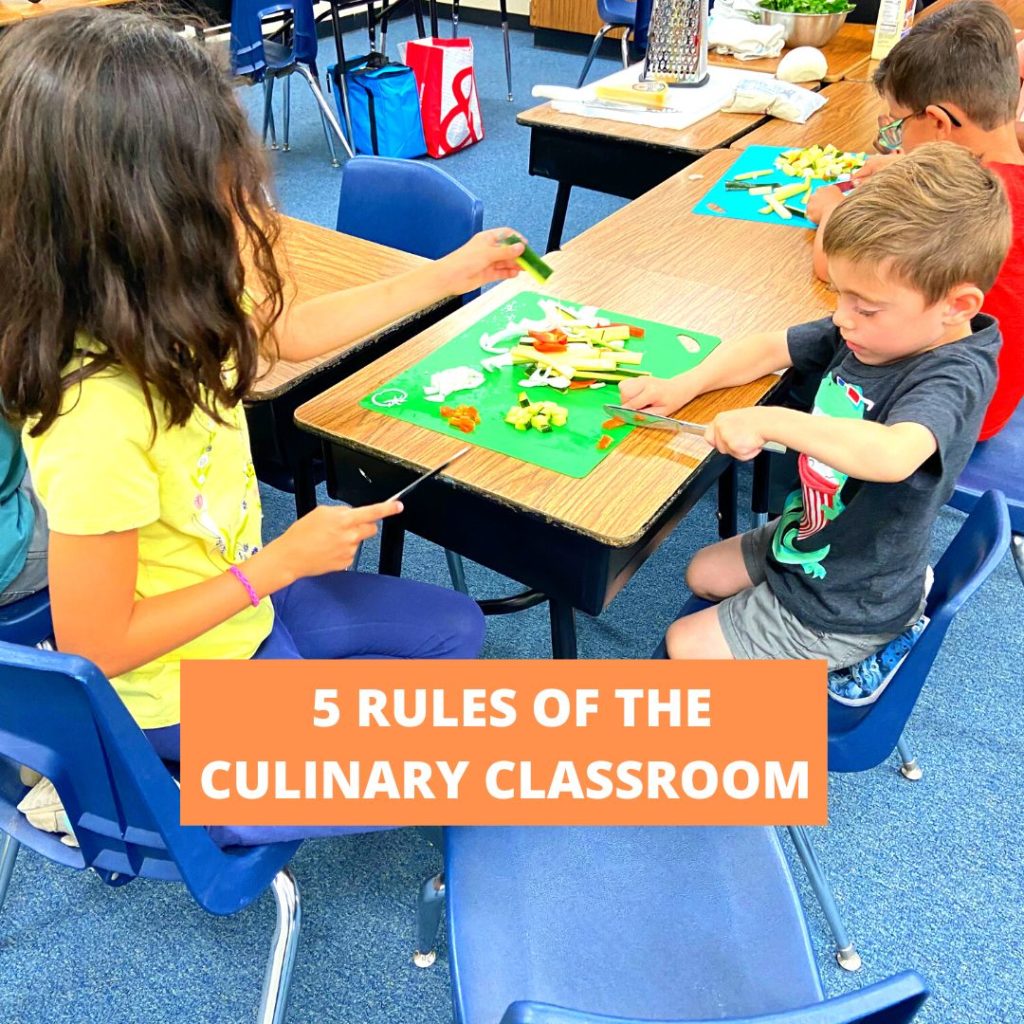
Every healthy culinary workshop we teach starts exactly the same, whether it’s an in-person lesson in a cafeteria with 20 kids in Pomona, CA or a virtual/hybrid class taught on zoom at a summer program Texas (and the Chef Teacher is in Idaho!):
We go over the 5 Rules of the Culinary Classroom.
The REAL reason we repeat these rules in every single workshop is for students to apply them when they cook one of our recipes at HOME. Our students, who typically attend Title-1 schools, need to learn the key lifeskill of making a meal from scratch using vegetables and simple ingredients, whether it’s Pasta Primavera with Zucchini or Black Bean & Spinach Quesadilla with Pico de Gallo.
These rules will help them have a cleaner and safer experience at home…but even adults could use them!
Rule 1: Mise En Plas
… (and how I messed this one up!)
Any chef knows that “Mise En Plas” is a French culinary term meaning “Everything In Place”
Before you start to cook, it makes life easier if you get all of your ingredients out in front of you so you don’t have to go searching for them when the oven is on and the pan is hot. You can also pre-measure ingredients so they are ready when you need them.
You can wash everything at once.
You can take care of most of your chopping in advance.
If you get your “Mise en Plas” all set and ready, you can be like a chef in a restaurant kitchen who can focus on cooking and nothing else when the order comes in. This means you don’t get distracted… and do what I did a few days ago.
It was a Sunday morning and I was making our signature Black Bean and Spinach Quesadillas with Pico de Gallo for a pool party I was invited to. It was a BBQ, so I figured some quesadillas would be a great appetizer as the entrees were being grilled.
I was in a new kitchen as I sauteed the spinach, rinsed the beans and had my cheddar cheese ready to go.
I figured I’d assemble a few quesadillas on a plate, then cook them on the pan and while that was happening I’d chop my tomatoes, cucumber and cilantro for the pico de gallo.
“I’m a chef…and I can multi-task!” I thought to myself.
I turned on the electric stove (it wasn’t the gas stove I’m used to!) let the pan-pre-heat, added a bit of oil and added two quesadillas to sear as I turned my attention to the salsa. I was also on a tight schedule to make it to this party at a reasonable hour.
As I carefully de-seeded the tomatoes (because I didn’t want the pico to be too watery), I noticed a bit of smoke coming from the pan! I raced over and flipped the quesadillas…but it was too late and the damage was done. They were (kinda) blackened, but not in an over-the-top way, but just enough that I would politely call them “extra crispy.”
I was immediately disappointed and knew I should have purely focused on the quesadillas!
I’m a “chef” and didn’t want to serve not-perfect quesadillas at a party where I was the new face.
Fortunately, I had some last minute help when a special someone assured me it’d be ok and I got back to work on making the salsa. Soon, a new batch of spinach was quickly sauteed and a bunch of very well-made quesadillas appeared in a flash.
My spirits lifted and I re-learned a valuable lesson…to NEVER EVER USE an electric stove again
(I’m kidding!)
The lesson was that I should have made the pico and given the quesadillas my undivided attention especially because I was using a stove and pan I wasn’t accustomed to.
Rule 2: The Paper Towel Trick
The paper towel trick is simple: Most cutting boards used at home move a lot and aren’t stable! By dampening a paper towel with a bit of water and unfolding it below a standard cutting board, the board immediately becomes safer to use.
It takes 2 minutes, and really makes chopping a lot easier and safer
Rule 3: Always Have A Kitchen Towel
Have you seen a video with Gordon Ramsey making eggs? He ALWAYS has a kitchen towel handy.
We ask students in our workshops “Why should you have a kitchen towel?”
They immediately understand how it can be used soak up the mess that inevitably will happen in a home kitchen!
Are tomatoes leaving a watery mess on your cutting board? Use a kitchen towel!
Did cilantro somehow get all over the place? Use a kitchen towel!
Did you spill the glass of water you were sipping on while cooking? Don’t worry! You’ve got a kitchen towel handy.
(Parents really appreciate it when their kids can cook AND cleanup at the same time)
Rule 4: Proper Knife Handling
In our healthy culinary workshops that we teach to student who lack resources, we show them:
- To hold a knife like a wand, so you have a solid grip
- If you walk with a knife, hold it facing down to the ground (just like with scissors)
- Never gesture while holding a knife
I see many adults make all of these mistakes…and it’s probably because they didn’t take a cooking class from LIFT Enrichment back in the day. ☺
Rule 5: Tucked Fingers
When chopping students in our workshops, students use metal dinner knives so that it’s safe, but they can still experience the fun of dicing up fresh produce.
We know that at home they’ll most likely be using a real chef knife as they cook with their families.
If you cup your fingers like the letter “C” you can ensure you don’t chop off the tips of your fingers as you use your knife. Most home cooks use one hand to hold down a slice of zucchini and the other hand to chop it…and the two hands are far from each other.
This technique seems counterintuitive, but it’s actually easier and safer to tuck your fingers and have the blade near it as you chop.
It’s hard to describe in writing, but important for kids to learn!
And those are our 5 Rules of the Culinary Classroom
We have a 10-point checklist when we do Teacher Evaluations for our Chef Teachers (and we do several a week, often remotely) and one of the most important elements is that the Chef Teacher goes over these rules at each workshop.
If you’d like your students at a Title-1 school to experience healthy culinary workshops (and you have access to an after-school grant like ASES or 21st century) reply back to me or (or email info@liftenrichment.com) subject line: Healthy culinary workshop (at your school)
Because these are GREAT skills to teach kids when they are young.
And they’re great techniques to keep in mind when you’re chopping tomatoes on a Sunday morning and might burn a quesadilla.
I just hope you have someone to help fix your mistakes and remind you that cooking is really about having a good time and sharing your food with people you care for 😉
Get Cooking,
Chef Eric Horwitz


